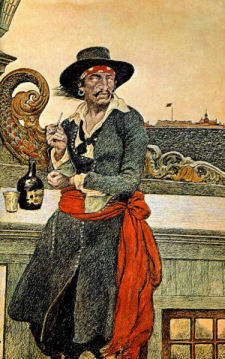| This Week’s Topic… | ||||

Best viewed in
|
William Kidd
Kidd's efforts to catch up with the "Blessed William" took him to New York, then a corrupt "anything goes" colony. Kidd settled there in 1691, aged 46, and married a wealthy widow, Sarah Bradley Cox Oort with whom he had two daughters, Elizabeth and Sarah Kidd. Kidd rapidly became a pillar of New York society with a country estate, a town house on Wall Street, and a growing interest in the cotton and tobacco trade with Britain. Meantime, however, the scourge of piracy and the threat it posed to wealthy traders had been growing, especially in the Indian Ocean. The Royal Navy of the day was in no position to police international waters. The Governor of New York and Massachusetts, the Earl of Bellmont, therefore formed a consortium to finance a ship that could take on the pirates. Other members of the consortium included the then Lord Chancellor, the First Lord of the Admiralty, the Master of the Ordnance, and a Secretary of State. Those involved genuinely wanted piracy tackled: but they knew they also stood to gain financially if their ship were to capture booty from pirate or French vessels. Even King William stood to gain one tenth of the value of anything taken.
The ship chosen for the expedition was the Adventure Galley, weighing 280 tons and equipped with 34 cannons, oars, and a crew of 150 men. Kidd's original crew was hand-picked, but shortly after setting sail from Deptford on 6 September 1696 he was stopped by HMS Duchess, who "pressed" half of his crew into service. The replacements, found in New York at short notice, were the dregs of the dockside taverns. Further problems followed. Kidd antagonized the powerful East India Company by abandoning three English vessels he was meant to be escorting into Cape Town. His first two attacks were on vessels supposedly under English protection. And a third of his crew died of cholera and had to be replaced in Madagascar. Kidd's crew became increasingly mutinous as he passed up a series of opportunities to attack rich English vessels, and during a fight he killed a gunner called Moore by hitting him with a wooden bucket. In 1697 the Adventure Galley made its way into the Red Sea, attacking a number of ships unrelated to the piracy Kidd had supposedly been sent to stamp out. Kidd's backers in England and America became increasingly nervous about what was happening. In January 1698, however, Kidd hit the jackpot, capturing the 300 ton Quetta Merchant and another ship, The Maiden. Both carried papers showing they were sailing under French authority to attack British vessels, and so constituted legitimate targets under the remit of the expedition. Kidd, however, breached instructions from his backers by distributing among his crew £10,000 made by selling part of the booty. He probably did this to avoid mutiny. By now the Adventure Galley was barely seaworthy, and Kidd docked in Ile St Marie, an infamous pirate den and the base of most of those he was meant to be hunting down. This was later taken as further evidence he had turned from pirate hunter to pirate. Kidd headed back for New York, unaware of the controversy caused by the voyage of the Adventure Galley. Passing through the Caribbean in 1699 he learned that the British had announced an amnesty for every Indian Ocean pirate except himself. Convinced of his own innocence, Kidd wrote to the Earl of Bellmont and then arrived in New York. Meantime the tide of public opinion had turned against privateers, and Kidd's own original backers were under considerable pressure because of their involvement with him. To prove his innocence, Kidd presented the Earl of Bellmont with the French papers captured on Quetta Merchant and The Maiden. These promptly disappeared, only being found amongst other unrelated papers in the Public Records Office in London two centuries later. Without his key defense documents, Kidd's fate was probably sealed anyway, but he further alienated public opinion by appearing to try to use part of the booty as bribes to secure his freedom. He was taken to Britain in February 1700. He failed to make a good impression when he appeared in front of the House of Commons on 27 March 1701. His trial in May 1701 on two counts of piracy and one of murder (of the gunner, William Moore) was a foregone conclusion, and on 23 May 1701 he was hung at Wapping, his body hanging beside the Thames for two years as a deterrent to others. Kidd's story is a mix of farce and tragedy. The truth is more one of a well intentioned man who overstepped the line, though probably no more so than most privateers of his day. What made Kidd's story different was the implications it had for people in very high places in the society of his day, who found him to be a very convenient scapegoat when public opinion shifted. Meanwhile, legends continue of vast hoards of treasure buried by Kidd on various islands to protect his fortune before he returned to New York. And he became the inspiration for Robert Louis Stevenson's classic pirate novel Treasure Island. |
|||
